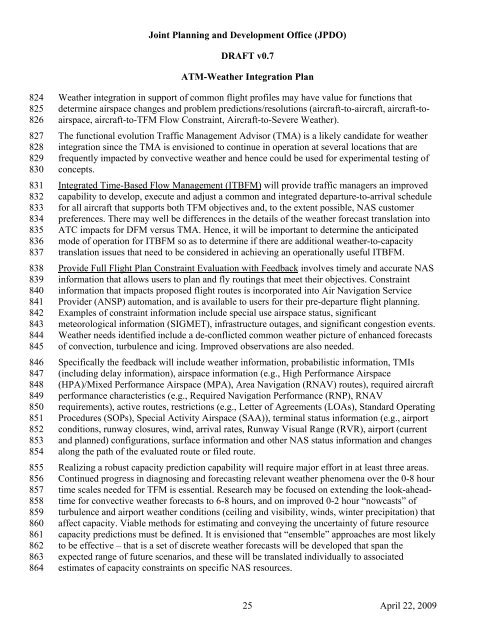ATM-Weather Integration Plan - Joint Planning and Development ...
ATM-Weather Integration Plan - Joint Planning and Development ...
ATM-Weather Integration Plan - Joint Planning and Development ...
Create successful ePaper yourself
Turn your PDF publications into a flip-book with our unique Google optimized e-Paper software.
<strong>Joint</strong> <strong>Plan</strong>ning <strong>and</strong> <strong>Development</strong> Office (JPDO)<br />
DRAFT v0.7<br />
<strong>ATM</strong>-<strong>Weather</strong> <strong>Integration</strong> <strong>Plan</strong><br />
824<br />
825<br />
826<br />
827<br />
828<br />
829<br />
830<br />
831<br />
832<br />
833<br />
834<br />
835<br />
836<br />
837<br />
838<br />
839<br />
840<br />
841<br />
842<br />
843<br />
844<br />
845<br />
846<br />
847<br />
848<br />
849<br />
850<br />
851<br />
852<br />
853<br />
854<br />
855<br />
856<br />
857<br />
858<br />
859<br />
860<br />
861<br />
862<br />
863<br />
864<br />
<strong>Weather</strong> integration in support of common flight profiles may have value for functions that<br />
determine airspace changes <strong>and</strong> problem predictions/resolutions (aircraft-to-aircraft, aircraft-toairspace,<br />
aircraft-to-TFM Flow Constraint, Aircraft-to-Severe <strong>Weather</strong>).<br />
The functional evolution Traffic Management Advisor (TMA) is a likely c<strong>and</strong>idate for weather<br />
integration since the TMA is envisioned to continue in operation at several locations that are<br />
frequently impacted by convective weather <strong>and</strong> hence could be used for experimental testing of<br />
concepts.<br />
Integrated Time-Based Flow Management (ITBFM) will provide traffic managers an improved<br />
capability to develop, execute <strong>and</strong> adjust a common <strong>and</strong> integrated departure-to-arrival schedule<br />
for all aircraft that supports both TFM objectives <strong>and</strong>, to the extent possible, NAS customer<br />
preferences. There may well be differences in the details of the weather forecast translation into<br />
ATC impacts for DFM versus TMA. Hence, it will be important to determine the anticipated<br />
mode of operation for ITBFM so as to determine if there are additional weather-to-capacity<br />
translation issues that need to be considered in achieving an operationally useful ITBFM.<br />
Provide Full Flight <strong>Plan</strong> Constraint Evaluation with Feedback involves timely <strong>and</strong> accurate NAS<br />
information that allows users to plan <strong>and</strong> fly routings that meet their objectives. Constraint<br />
information that impacts proposed flight routes is incorporated into Air Navigation Service<br />
Provider (ANSP) automation, <strong>and</strong> is available to users for their pre-departure flight planning.<br />
Examples of constraint information include special use airspace status, significant<br />
meteorological information (SIGMET), infrastructure outages, <strong>and</strong> significant congestion events.<br />
<strong>Weather</strong> needs identified include a de-conflicted common weather picture of enhanced forecasts<br />
of convection, turbulence <strong>and</strong> icing. Improved observations are also needed.<br />
Specifically the feedback will include weather information, probabilistic information, TMIs<br />
(including delay information), airspace information (e.g., High Performance Airspace<br />
(HPA)/Mixed Performance Airspace (MPA), Area Navigation (RNAV) routes), required aircraft<br />
performance characteristics (e.g., Required Navigation Performance (RNP), RNAV<br />
requirements), active routes, restrictions (e.g., Letter of Agreements (LOAs), St<strong>and</strong>ard Operating<br />
Procedures (SOPs), Special Activity Airspace (SAA)), terminal status information (e.g., airport<br />
conditions, runway closures, wind, arrival rates, Runway Visual Range (RVR), airport (current<br />
<strong>and</strong> planned) configurations, surface information <strong>and</strong> other NAS status information <strong>and</strong> changes<br />
along the path of the evaluated route or filed route.<br />
Realizing a robust capacity prediction capability will require major effort in at least three areas.<br />
Continued progress in diagnosing <strong>and</strong> forecasting relevant weather phenomena over the 0-8 hour<br />
time scales needed for TFM is essential. Research may be focused on extending the look-aheadtime<br />
for convective weather forecasts to 6-8 hours, <strong>and</strong> on improved 0-2 hour “nowcasts” of<br />
turbulence <strong>and</strong> airport weather conditions (ceiling <strong>and</strong> visibility, winds, winter precipitation) that<br />
affect capacity. Viable methods for estimating <strong>and</strong> conveying the uncertainty of future resource<br />
capacity predictions must be defined. It is envisioned that “ensemble” approaches are most likely<br />
to be effective – that is a set of discrete weather forecasts will be developed that span the<br />
expected range of future scenarios, <strong>and</strong> these will be translated individually to associated<br />
estimates of capacity constraints on specific NAS resources.<br />
25 April 22, 2009

















